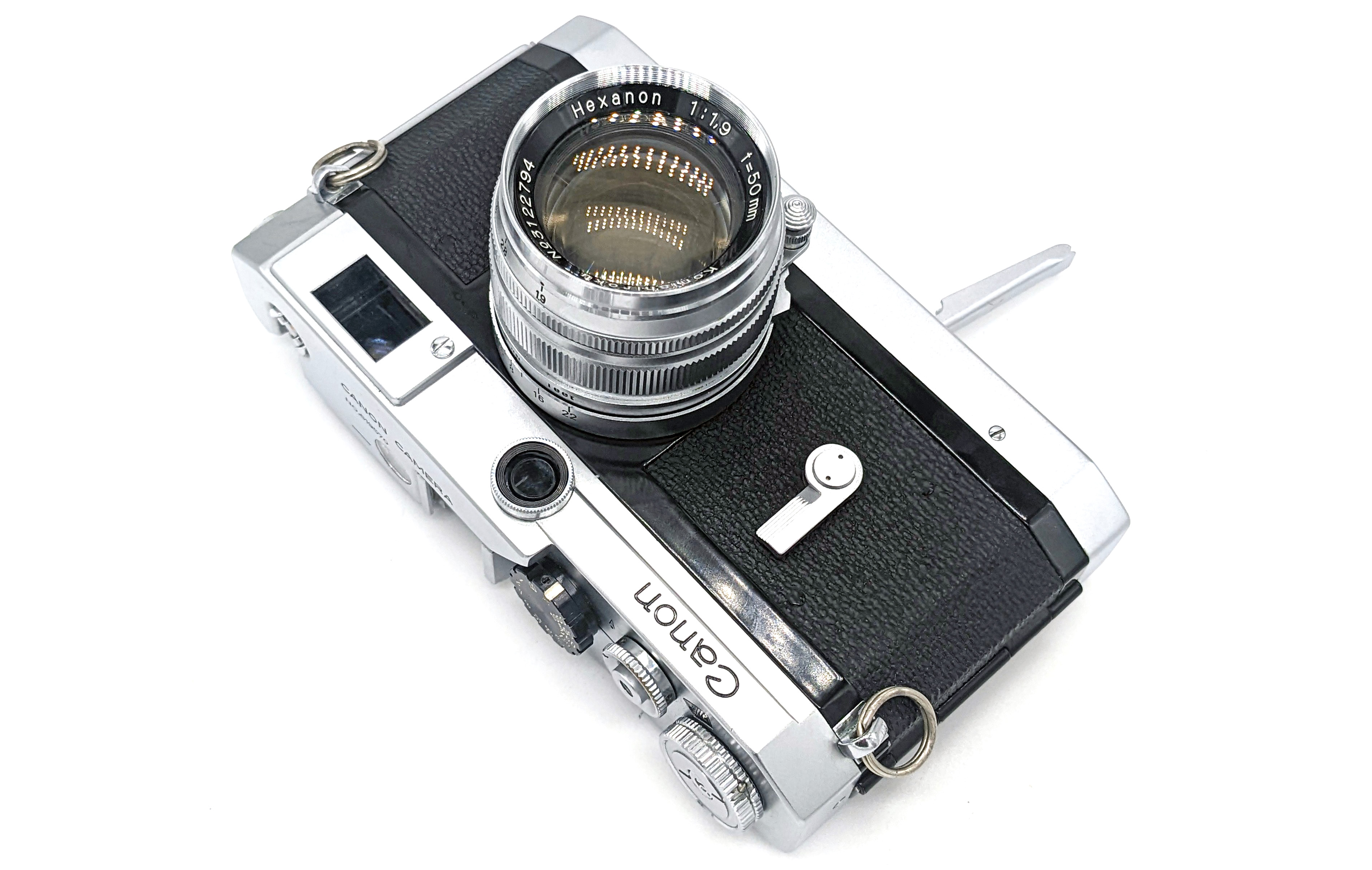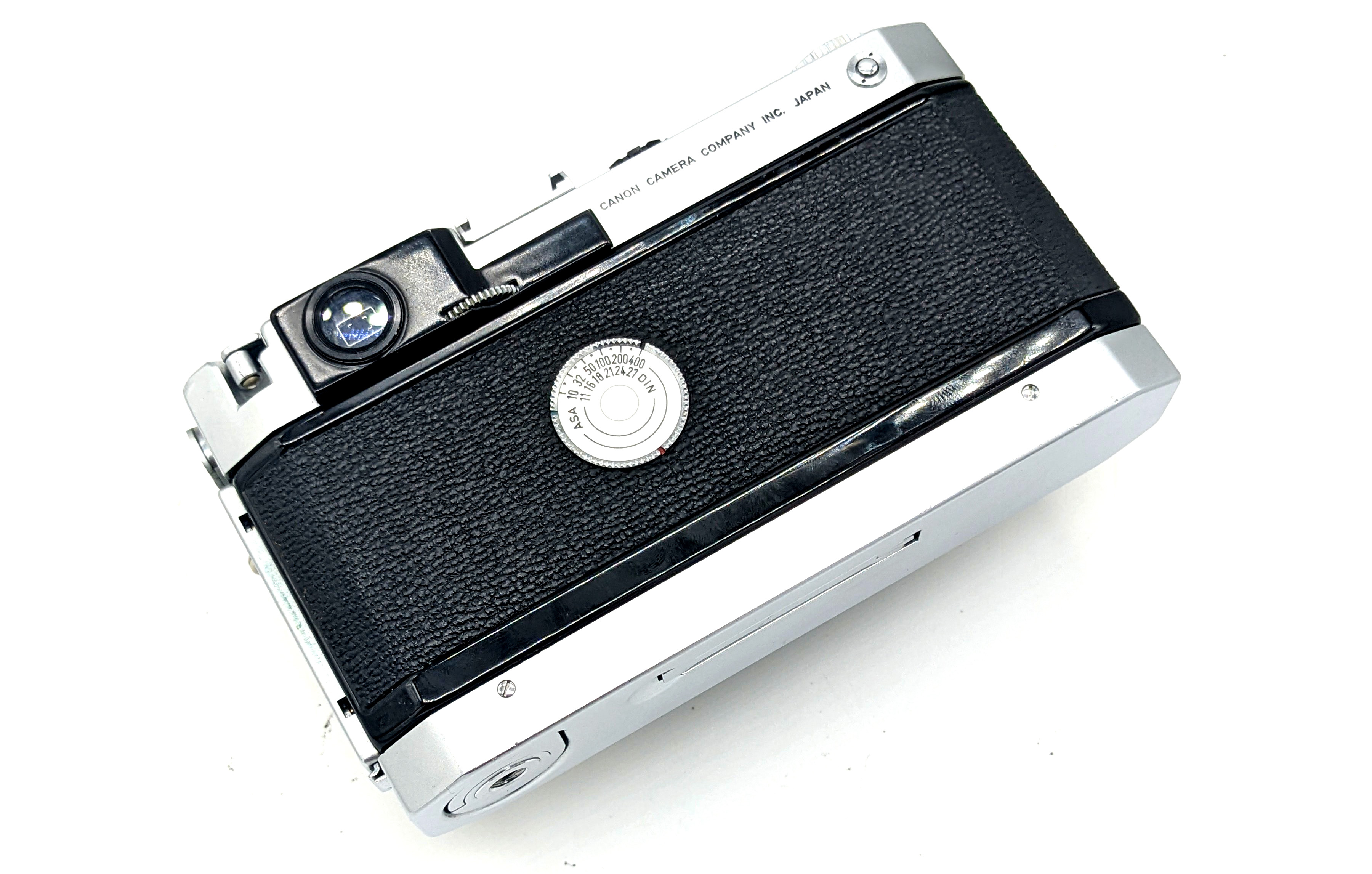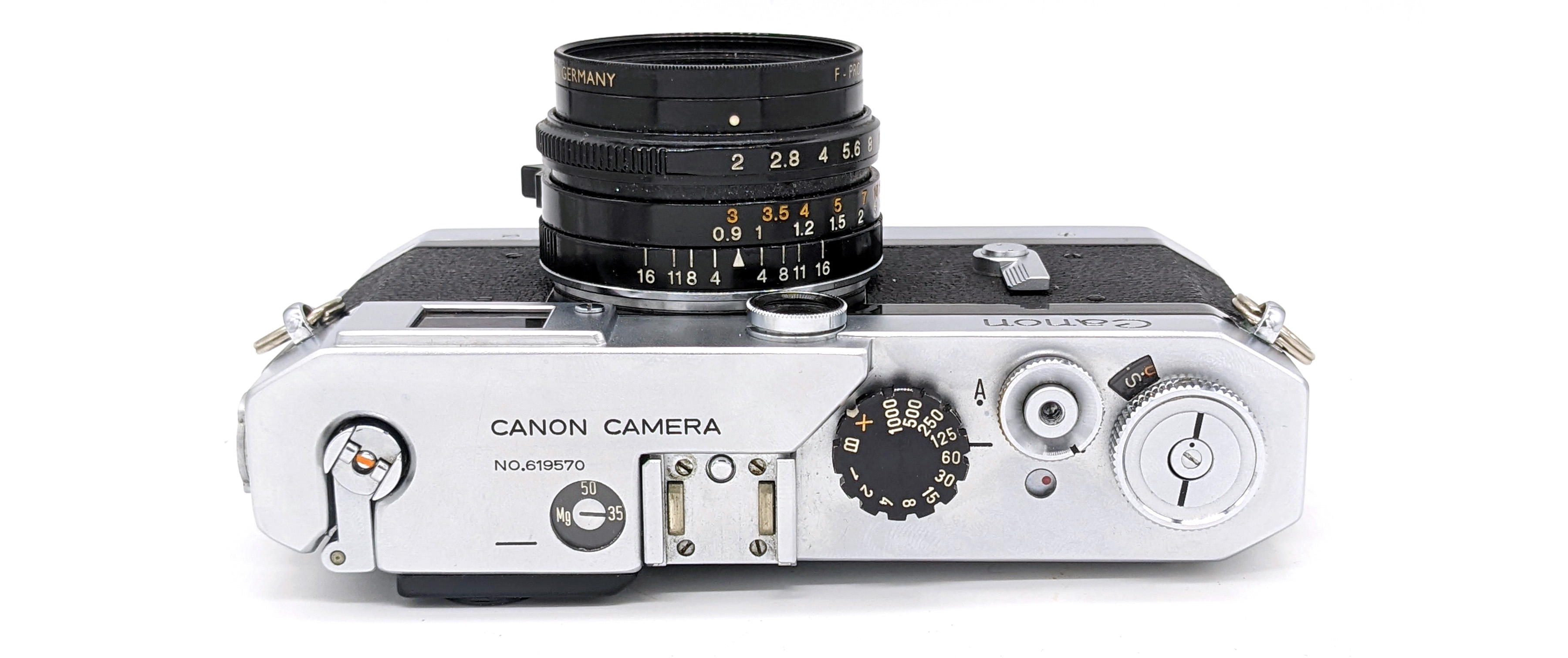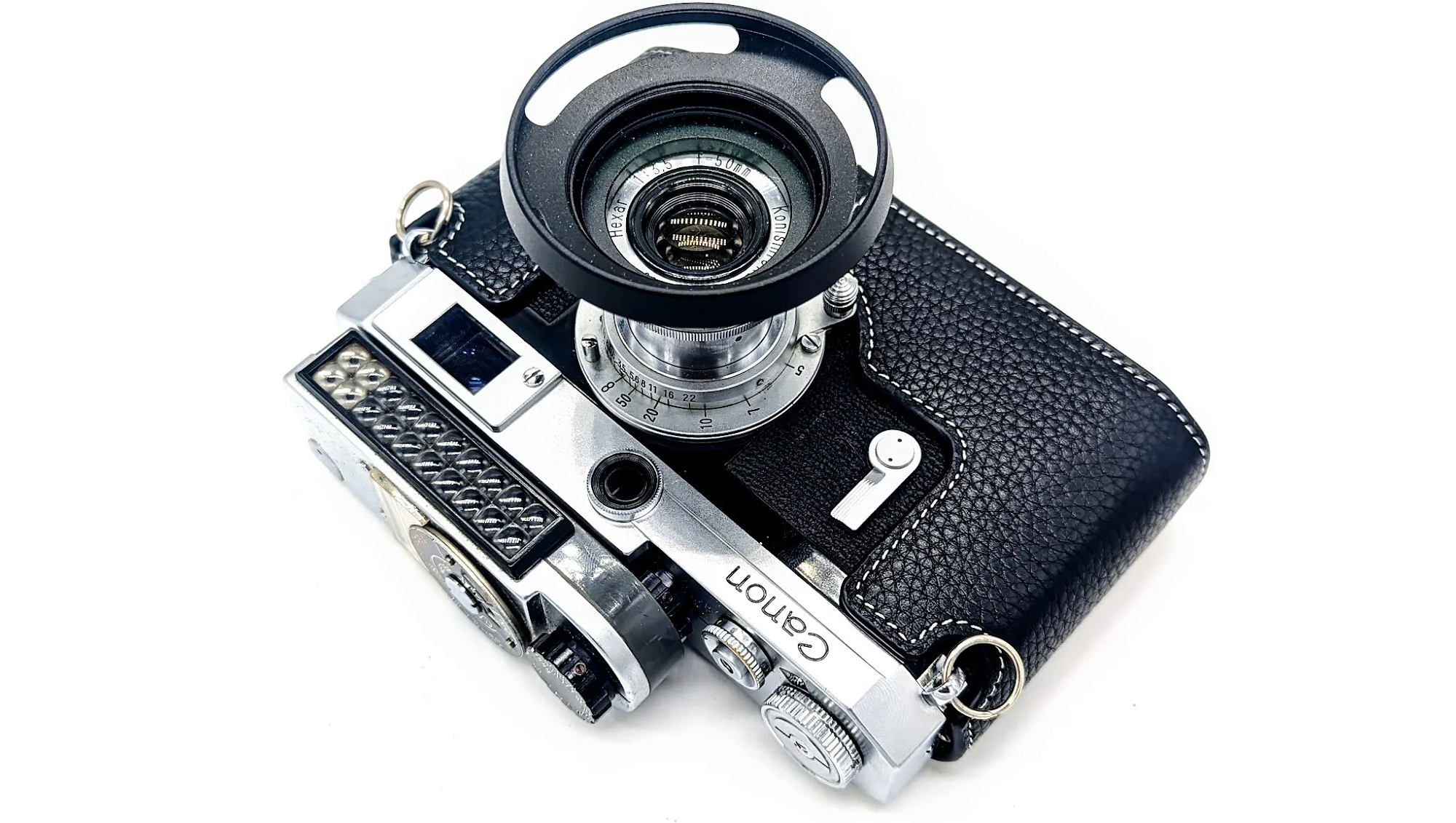
Canon’s 1958 VI-T makes a good case for being the most interesting interchangeable-lens 35mm rangefinder camera of the 1950s. Although overshadowed during the time (as well as today) by the Leica M2 & M3, the Nikon SP, and Canon’s own ubiquitous economy model, the “Populaire,” the VI-T has some functionality that all of these models lacked. Because of the VI-T’s relative rarity (only around 8,000 were produced), it remains arguably one of the better-kept secrets in the rangefinder world.
From the late 1940s through the late 1950s, various manufacturers, mostly located in Japan, flooded the market with copies of the Leica III at a cheaper price point. Although the majority of these models exhibited exceptional quality and finish, as a whole, they did little to improve substantively upon the template. The best that could be said is that a few models introduced nice features such as a lever (rather than knob) advance and swing-back film loading; but those were the exceptions rather than the rule.
For its part, Canon was one of the few companies innovating with the M39 platform beyond that provided by the Leica Barnack template. Canon’s 1946 S II was apparently the first interchangeable-lens M39 camera with a combined rangefinder and viewfinder. In 1949, Canon upped the game with its IIB, a camera that had a three-position combined rangefinder / viewfinder that could change the viewfinder magnification among approximate 50mm, 100mm, and 135mm views. The next iconic models were the 1952 IVSB and 1954 IVSB2, which not only retained the three-position finder, but also had a 1/1000 top shutter speed and an X-sync for modern electronic flashes.
In 1956, Canon responded to the M3 and Nikon’s S2 with the “VT,” with the definitive model being the 1957 VT Deluxe. The VT was a significant redesign of the IVSB series and incorporated a host of impressive features for an M39 camera: a three-position combined rangefinder / viewfinder, a bottom trigger advance, a new 50mm f/1.2 standard lens, swingback film loading, and the ability to use proprietary parallax-corrected external viewfinders that would automatically reframe as the lens focus moved. Still, the VT still left a few things to be desired. First, the rotating viewfinders did not contain any framelines. Second, it retained the Barnack-style dual high-speed / low-speed independent shutter speed dials.
Canon spent much of 1957 and 1958 producing various iterations of the VT: (1) the 1957 L2 (lever advance, 1/500 top speed, no X-sync); (2) the 1957 L1 (lever advance, no self timer); (3) the 1957 L3 (lever advance, 1/500 top speed, no flash sync); (4) the 1958 VL (a VT Deluxe with a lever wind); and (5) the 1958 VL2 (lever wind, knob rewind, 1/500 top speed).
During the autumn of 1958, Canon launched a significant upgrade to the VT line in the forms of the VI-T (trigger advance) and the VI-L (lever advance). The VI was usually bundled with either the 50mm f/1.2 or 50mm f/1.8 lenses. By 1959, these models were selling for about $220 with a Canon 50mm f/1.8 lens (around $2,100 in today’s dollars), less than the $280 price for an M3 body (@ $2,600). Retaining the VT’s rotating viewfinder (0.65x, 1.00x, and 1.55x) while adding parallax-corrected framelines for 50mm and 100mm lenses, the VI series also combined the shutter speeds into a single dial. The VI-T had a built-in trigger advance, where Leica required the expensive “Leicavit” accessory. The VI series had swing-back loading, while Leica continued with its bottom-loading. The VI series also provided a demagnified view for 35mm lenses, whereas the M3 required specialized “goggled” lenses.
Despite being the most advanced Canon M39 rangefinder to date, it does not appear that the VI-T or the VI-L received much fanfare in North America. Maybe the 1958 worldwide recession had hit a little too hard, maybe the public did not see any meaningful differences between the V and the VI, and/or maybe the 35mm camera market at the time was just too overloaded. In any event, the fact that only about 19,000 examples of the VI series were produced between 1958 and 1961 explains why they are relatively rare cameras today.
Canon’s final stab at the V/VI platform was the 1959 economy model, the lever-wind “Populaire.” Most likely meant to compete with the Nikon S3, the P has a parallax-corrected, cluttered, but life-sized for 35mm lenses, viewfinder with fixed 35/50/100 framelines. Despite its slimmed-down specifications, the P was successful commercially, selling more than four times as many units as the VI series.
To be sure, during the last gasps of the Barnack era, several other Japanese manufacturers followed Canon’s lead and attempted to introduce combined viewfinder/rangefinder 35mm M39 cameras, with none of them being produced in significant quantity. These models include the Yashica YF, Leotax G, Honor SL, and Tanack V3 and VP. Most of these models are expensive collectors’ items today and in terms of features have really nothing over the Canon V or VI.
By the early 1960s, Canon was the last major, non-Eastern-bloc maker of M39 lenses. Nikon halted production of M39 lenses by early 1960s. Leica continued to make a limited number of M39 versions of some of its M lenses until about 1963, most likely to accommodate the run of its IIIg model. Although the quality of Canon’s M39 lenses varied, it did have a few winners, like the 50mm f/1.4 II, the 25mm f/3.5, the 85mm f/1.8, and the 100mm f/2 and f/3.5. Canon’s last “new” M39 lens would be its “pretty good” 1962 35mm f/2. I think the later Canon rangefinder lenses are fairly capable, but I just do not like the ergonomics of most of them. None of them could natively focus below 1.00m.
With much of the the attention focused these days on the easy-to-find and relatively-cheap VT (and its variants), P, and later 7 series, the VI appears to be a bit under-appreciated. With the VI being relatively rare and increasingly pricey, let’s take a closer look at its strengths and weaknesses and whether it can offer us a pleasant and useful rangefinder experience in the 21st century.

Specifications (Compared)
Here are the Leica M3, Leica M2, the Canon VI, the Canon P, and the Canon 7 compared:
| M3 | M2 | VI-T | P | 7 | |
| Year Introduced | 1954 | 1957 | 1958 | 1959 | 1961 |
| Weight (Body) | 580g | 560g | 645g | 650g | 622g |
| Speeds | B, 1 – 1/1000 | B, 1 – 1/1000 | B, 1 – 1/1000 | B, 1 – 1/1000 | B, 1 – 1/1000 |
| Shutter | Horizontal Cloth | Horizontal Cloth | Horizontal Metal | Horizontal Metal | Horizontal Metal |
| Framelines | 50/90/135 | 35/50/90 | 35 (No Frameline); 50/100 | Fixed 35/50/100 | Switchable 35/50/85/100/135 |
| Frameline | Projected | Projected | Reflected | Reflected | Projected |
| Parallax Corrected? | Yes | Yes | Yes | Yes | Yes |
| VF Mag | 0.92x | 0.72x | 0.65x / 1.00x @ 50mm / 1.55x | 1.00x @ 35mm | 0.80x |
| Effective RF Baselength | 62.3mm | 49.32mm | 28.7mm / 41mm / 61.5mm | 41mm | 47.2mm |
| Film Loading | Bottom | Bottom | Swing Back | Swing Back | Swing Back |
| Film Rewind | Knob | Knob | Crank | Crank | Crank |
| Film Advance | Lever | Lever | Trigger & Knob | Lever | Lever |
| X Sync | 1/50 | 1/50 | 1/55 | 1/55 | 1/60 |
| Parallax Pin | No | No | Yes | No | No |

Functionality
The entirely-mechanical VI-T is a well-built and solid-feeling device that certainly exudes the qualities of a bygone age.
Minimum Focusing Distance: On at least the VI and the P, it appears that both can rangefinder couple down to around 0.7m (or maybe just short of that). This is somewhat interesting as Canon never made an M39 lens that could natively focus more closely than 1.00m. This minimum focus capability comes in handy if you own M39 lenses that can take advantage of close focus. As far as I know, the only classic M39 lenses than could natively focus more closely than 1.00m with rangefinder coupling was the 50mm f/1.4 Nikkor. However, many Voigtlander M39 lenses from the last 20 years can focus down to 0.7m.
Viewfinder: From 1949 until its abandonment of the concept after the VI, Canon really pushed the concept of a three-position rotating viewfinder with different magnifications. In theory, this was an excellent idea; but Canon’s execution of it left something to be desired. While the rangefinder patch is a rather faint circular type, it is fairly easy to use in practice in both daylight and low light. Not as good as Leica Ms but arguably a bit better than Nikon rangefinders.
50/100: The VT’s version of this finder position contains no framelines. Instead of the .92x magnification used on the M3, Canon chose 1.00x (life-sized) for its standard finder position at 50mm. The VI introduced the reflected 50mm and 100mm framelines that were both parallax corrected, which was a significant improvement. Whether you like the 1.00x magnification option would come down to how you prefer to take photos. In theory, this magnification was most effectively used by right-eyed shooters (without glasses) where both eyes could remain open. The visual effect is that the scene appears bright as normal life but you can also focus the rangefinder at the same time. However, a life-sized finder is not so great for left-eyed shooters, especially those with glasses. I prefer the M3 approach of a slight demagnification of the viewfinder that permits full viewing by left-eyed shooters with glasses. Similar to the contemporary Nikon S3, the P’s cluttered viewfinder would abandon the life-sized 50mm view for a life-sized 35mm view.
35: The VI retained the same 35mm viewfinder position from the VT, also with no framelines. For the 35mm focal length, parallax correction is not really necessary. This view has some barrel distortion. With glasses, the 35mm view can be pretty difficult to use.
Magnified: The VI carries over the VT’s magnified view for “critical focus.” This position would ideally be for lenses at 100mm or longer.
Rangefinder Baselength: The 41mm effective rangefinder baselength of the VI is good enough to focus with accuracy the Canon rangefinder lenses of the era. However, Nikon and Leica rangefinders both had longer effective rangefinder baselengths. Even the magnified view position of the VI (1.55x) in theory was not as accurate as the M3’s standard viewfinder at 50mm. The 7 would improve this somewhat to 47mm. The circular rangefinder patch itself is not as bright or distinct as in a Leica M, but to me it is better than Nikon rangefinders. At the 35mm position, the 28.7mm effective baselength is adequate for that wider focal length.
Shutter Speeds: The VI was the first Canon M39 rangefinder with a single shutter speed dial with equal spacing between speeds. The 1 sec to 1/1000 was par for the course for the era.
Shutter: Canon switched from cloth to metal shutter curtains with the 1958 VL and continued with this type of shutter through the 7 series. Canon’s metal rangefinder shutters have generally held up well over the decades, despite sometimes becoming crinkled from nosey fingers. The sound of the shutter is muted and pleasant.
Film Loading: The VI series employs a modern swingback film loading system with a door key on the bottom plate and a door latch at the bottom of the hinge. The film loading is performed by lifting up the rewind crank, inserting the film, lifting up the advance knob activated by a button the back of the body, and then slowly turning the knob so that the film spools on the takeup. Reset the knob, close the back, and then turn the bottom key to lock.
Film Advance: On a VI-T, advancing the film can occur in two separate ways: via the bottom fold in trigger or by engaging the advance knob and turning it until it stops. The single-stroke trigger advance is somewhat unusual but pretty great once you get the hang of it. When not in use, it folds into the bottom plate of the camera.
Film Rewinding: The film is rewound by by switching the ring around the shutter button to “*” and then rewinding the crank.
Flash Sync: The VI carried over the X-flash sync speed from the VT at 1/55. The flash sync terminal is on the side of the camera and will require the appropriate PC cable if a modern electronic flash is used.
Automatic Parallax Correction Viewfinders: One of Canon’s most innovative contributions to rangefinder technology was to create a mechanical linkage between the camera and an accessory viewfinder to automatically correct parallax error. Other manufacturers’ viewfinders would require dialing in the focus distance to the viewfinder while others had no parallax correction at all. While this system was abandoned after the VI, no other manufacturer had something like this. This capability is best suited for the use of 50mm and telephoto lenses, where parallax error can be significant, especially at closer focusing distances.
Self-Timer: The VI has a standard front switch for self-timing needs.
Double Exposures: The VI has a fairly complicated way of taking double exposures, which involves releasing the film advance, manually rewinding the film rewind crank, relocking the film advance and then advancing the film transport knob.

Accessories
Coupled Selenium Meter: Compatible only with the VI series and the P, Canon produced a shoe-mount selenium light meter that coupled directly to the shutter speed dial. Unlike most selenium meters from the time, it appears that a fair number of examples out there still work. The meter also had an accessory “incident” metering attachment as well as a “booster” for lower-light situations. To ease access to the rewind crank, Canon introduced a second version that allowed the light meter unit to pivot from the shoe mount.
Case: The VI had a two-part leather case. Using the bottom half of the case, while blocking the loading and unloading of the film, is a good idea to protect the body from unnecessary scratches.
Camera Holder: Canon offered a bracket for the VI that permitted easier operation on a tripod.
Accessory Finders: With the V and VI series, Canon’s contemporary accessory viewfinders would permit automatic parallax correction through a mechanical linkage on the hot shoe. The most interesting Canon viewfinder is the (expensive) “Twin Turret” that provided two lenses that could cover the 21-135mm range.
Pistol Grip: The V and VI could theoretically benefit from the “Pistol Grip” mounted to the tripod socket that permitted an alternate way to hold the body and utilize the trigger wind. This seems to be a rare OEM accessory.
Diopters: Perhaps the rarest rangefinder accessories of all time, Canon apparently produced a series of removable viewfinder diopters for eyesight correction so that shots can be taken without glasses. So far, very few people have actually seen one. This would be a great candidate for reproduction by some budding camera entrepreneur.

Conclusions
Given the VI’s unique design, it is somewhat difficult to make direct comparisons to other contemporary products. The VI is overall better than any Barnack camera, all Canon rangefinders that came before it, and the P. The P substitutes a more useable 35mm view for a more cluttered viewfinder. Against the 7, it is a difficult comparison. The bigger, more advanced, but not as ruggedly-built 7 adopted the Leica M philosophy of having a single viewfinder magnification with rotating projected framelines for the common focal lengths. The lower viewfinder magnification pretty much eliminated the “life-sized” right-eyed shooting technique and thus is better for those wearing glasses. The built-in, uncoupled meters on the 7 and 7s models really offer no real world advantage over using a modern shoe-mounted meter. However, the spirit of the 7 did live on with the Voigtlander Bessa M and M39 cameras. that also chose to use a switchable projected framelines system, rather than the rotating viewfinder of the V/VI. If you are shooting mostly 35/50/100, whether you prefer the 7 or the VI would come down to personal preferences.
Against the M3, the VI has a hard time. The M3 has a better viewfinder that is more resistant to flaring, a more distinct rangefinder patch, and its effective rangefinder baselength is longer at 50mm than the VI-T’s “magnified” focus setting at 1.55x magnification. However, in terms of everything else about these cameras, they function pretty much the same. The Ms and the VI-T have the same shutter speeds and similar flash sync speeds. Over the M3, the VI-T has easier film loading, faster film rewinding, a trigger film advance for faster shooting, a native ability to use 35mm lenses, and an accessory pin that allows automatic parallax correction with certain Canon viewfinders. Despite any perceived advantages, whether you would think that the M3 would simply blow a camera like the VI out of the water will probably come down again to your personal preferences and maybe wallet size.
At the end of the day, the VI remains arguably Canon’s crowning achievement in rangefinder camera design. With not many produced, a VI in serviceable condition can be a little hard to find. Because most of these cameras have been sitting on shelfs and in closets for decades, before taking one out, I would recommend a good viewfinder cleaning and a once-over on the shutter speeds and rangefinder alignment. Once working properly, these types of cameras could last forever with care and proper maintenance.